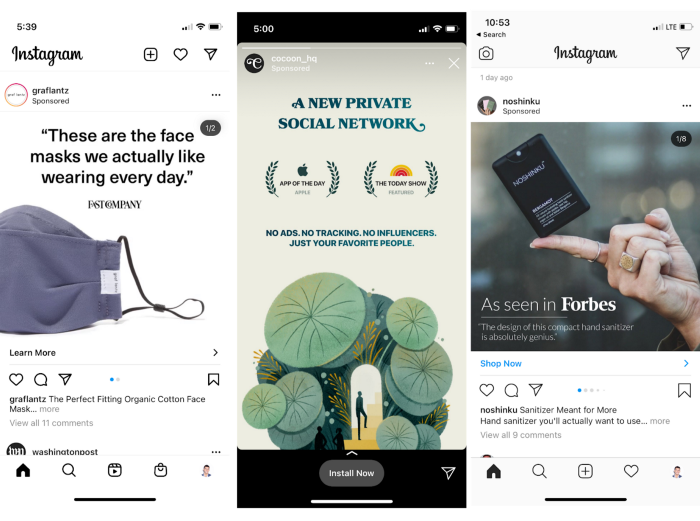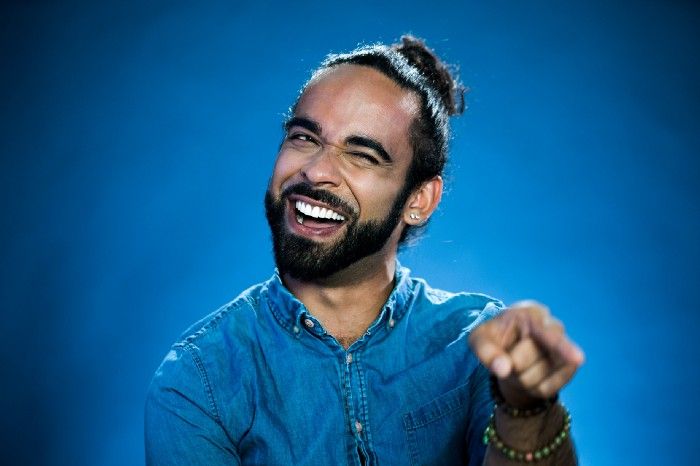Pop quiz: How much can you learn about someone by peeking at the recent social media ads they’ve been targeted with?
You tell me. Here are some screenshots of what I’ve seen lately on Instagram:

Let’s see… blankets, candles, artsy puzzles… yup, 34-year-old gay man targeted perfectly. Damn, Instagram, you are good. 🙋🏻♂️ There was another common thread in those ads, though. Did you catch it? Not sure? Here, lemme give you three more:

See it yet?
Of all the different brand creative these startups could have used — reviews, product specs, video content — these advertising agencies chose to introduce me to their product via ads that have “as seen in” media logos.
New York Times. Forbes. Fast Company. Glamour. I’ve never seen these products before, but if they’re good enough to get covered by household-name outlets, they must be either established or the hottest new thing on the market.
I’m programmed to think this way — and this is the power of earned media. While many founders think of publicity as a visibility tactic — “get seen by millions”, an ego boost, and perhaps some slippery impressions data — its bigger power emerges in the weeks and months after you’ve been covered… when leveraged correctly.
Most Exposure Is Short-Lived
Unless you’re on a Netflix show and get a glowing narrative (Example: Morgan in Cheer), or do something totally unique and bonkers (Like this woman who does astral snake massage), you’re probably not going to get a massive exposure hit from a media placement. Even when I slay on Entrepreneur, it doesn’t lead to a huge volume of inbound requests or so much traffic my website melts.
What you do get, however, is the credibility marker that comes with earned media. According to a report from Cision, 92% of consumers trust earned media, whereas only 50% trust paid ads. Even in our modern times, in which fake news or overly spun reporting runs rampant, most media outlets remain content powerhouses that command high readership and, in some cases, decades of credibility.
“92% of consumers trust earned media, whereas only 50% trust paid ads.”
This is because, whether you like it or not, you were conditioned day in and day out that “as seen in” is synonymous with quality. The good news is that your readers and potential customers have this same conditioning, too.
- If a men’s suit is featured as “the perfect suit for summer” in GQ, you make a snap judgment about that suit and its quality.
- If a phone charger is heralded as “a terrific deal” by WIRED, you make an assumption that WIRED has compared chargers and recommends only the best ones.
- And if someone’s new book gets featured by Oprah on Super Soul Sunday, chances are good that the publication is one of the best and most compelling finds on bookshelves today.
This conditioning is subconscious and has been ingrained in us over many years. And while the media landscape itself is changing, this conditioning will likely take decades to deprogram (if ever).
If you plan to run ads, promote your personal brand, or pursue future funding, earned media should probably be in your sights sooner rather than later. As a bonus, press can be landed once, but add credibility to your startup for months and years to come.
That being said, publicists and PR agencies can get expensive. And when you’re just getting started, you may be able to land some initial wins for free.
So here are 5 easy PR hacks you can implement or double-down on to start locking down the logos.
#1: Know The Outlet and Its Audience
I have an industry peer who was previously a national TV producer. I’ll never forget a time we were at a speaking engagement together; in her presentation, she prompted a room full of starry-eyed entrepreneurs with the following question:
“Who here wants to be on Good Morning America?” (A popular morning TV show in the U.S.)
Every hand in the room went up.
“Great. So do you watch the show?”
Every hand went back down just as quickly as it had gone up.
Her exercise illustrated an important point: Most entrepreneurs don’t watch or read the news. That’s okay, but it means that when you go to pitch, you need to do some research to know the outlet you’re pitching, what they cover, and how they deliver that information.
#2: Research Potential Contacts (But Don’t Be A Stalker)
If a publicist tells you they pitched you to 650 outlets this week… run away. Editors and producers can see right through stock pitches; your chances of placement are much better if you can get on a gatekeeper’s radar, then build some rapport over time. For example, if your company uses emerging A.I. technology, you’d want to
- Research what journalists cover A.I. on a somewhat regular basis,
- Follow them on Twitter or some other social media and get a feel for what they’re talking about and writing lately,
- Interact casually and add value through actions like leaving thoughtful comments and sharing their work, and
- Send over a pitch when you’re ready that clearly shows you’ve thought through your idea and how it would fit the outlet.
#3: Personalize Your Pitch
Think about how you can make your pitch unique. Why are you pitching this particular editor? Why is your story compelling and incredible? How you position your story is sometimes even more important than the story itself. Here are a few additional questions to think about when constructing your pitch.
- What’s the hook? This is still a game of persuasion, and step one is to capture someone’s attention. I like to add personal details here about their recent activity on social media to signal right from the get-go that this is not a stock pitch.
- Why is this story a fit for their outlet and their audience? Remember: Make it about them.
- Keep it informative, but short and sweet. I do 4–5 sentences max and a few bullets. You want to leave gatekeepers wanting more.
#4: Know The Basics Of Media Training
This is where startup founders and entrepreneurs often blow it. “Media training” refers to how to conduct yourself in an interview to ensure you retain control of your message. In TV and other video placements, media training also refers to how you appear on camera.
Some of the components of media training are obvious — identifying whether your eyes dart around while you speak, or including too many filler words in your responses. But others are more subtle and nuanced.
You’ve worked hard to secure a placement; we now want to ensure you’re talking about your startup and story for as much of the interview as possible. Without media training, founders and entrepreneurs often subvert themselves to the interviewer’s questions and get whisked off on tangents that don’t relate to your company.
Know the basics of media training to maximize your message.
#5: Leverage Your Results
Most entrepreneurs overestimate the reach that will come from a placement and underestimate how much they can self-promote the media hit for themselves. If you’ve landed a placement with a media outlet once… you’ll have it locked in and can drop that “as seen in” lingo forever. Remember those placements we saw at the top of this article? Who’s to say those accolades weren’t earned years ago? It doesn’t matter when the placement happened; all that matters is that it happened in the first place. Once you’ve landed a placement, you can incorporate it into your overall marketing plan and lift brand affinity forever.
---
Media and PR placements can be great ways to add credibility, authority, and trustworthiness to your brand. And the good news is that you can start doing some of the leg work yourself if you’re on a shoestring budget. Seek out those who cover your industry, put together a thoughtful pitch, and those game-changing accolades might be closer than you think. ◆
Thanks For Reading 🙏🏼
Keep up the momentum with one or more of these next steps:
📣 Share this post with your network or a friend. Sharing helps spread the word, and posts are formatted to be both easy to read and easy to curate – you'll look savvy and informed.
📲 Hang out with me on another platform. I'm active on Medium, Instagram, and LinkedIn – if you're on any of those, say hello.
📬 Sign up for my free email list. This is where my best, most exclusive and most valuable content gets published. Use any of the signup boxes on the site.
🏕 Up your writing game: Camp Wordsmith is a free online resources portal all about writing and media. Get instant access to resources and templates guaranteed to make your marketing hustle faster, better, easier, and more fun. Sign up for free here.
📊 Hire me for consulting. I provide 1-on-1 consultations through my company, Hefty Media Group. We're a certified diversity supplier with the National Gay & Lesbian Chamber of Commerce. Learn more here.






